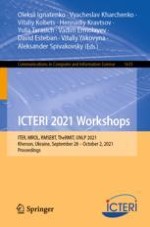This book contains the workshops papers presented at the 17th International Conference on Information and Communication Technologies in Education, Research, and Industrial Applications, ICTERI 2021, held in Kherson, Ukraine, in September-October 2021.
The 33 revised full papers and 4 short papers included in this volume were carefully reviewed and selected from 105 initial submissions. The papers are organized according to the following workshops: 9th International Workshop on Information Technology in Economic Research (ITER 2021); 5th International Workshop on Methods, Resources and Technologies for Open Learning and Research (MROL 2021); International Workshop RMSEBT 2021: Rigorous Methods in Software Engineering and Blockchain Technologies; 7th International Workshop on Theory of Reliability and Markov Modeling for Information Technologies (TheRMIT 2021); 1st Ukrainian Natural Language Processing Workshop (UNLP 2021).
